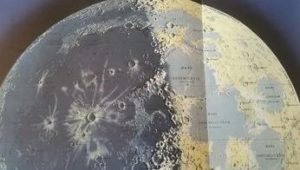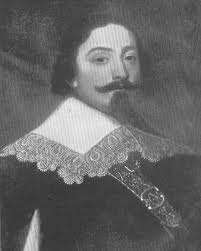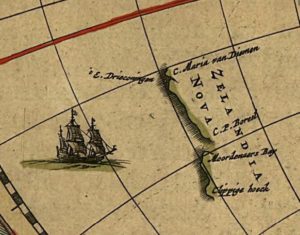1647: New Zealand
March 29, 2021
By AHNZ
New Zealand is a Dutch discovery and the naming of our country was the cutting-edge part a ground-breaking and bold Enlightenment statement to the world. Able Tasman took his discovery home to Holland where it was added to the charts¹ by master cartographer Joan Blaeu as Nieuw Zeeland (Dutch) or Nova Zealandia (Latin) or New Zealand (English.)
 As those educated in the sciences already know, when you make a discovery you are entitled to bestow the name. You don’t get money for coming up with Newton’s Laws or Watts of power of degrees Kelvin, Mach speed or Cartesian coordinates but you get naming honors. This is also why there is a dinosaur named after the front-man for Dire Straights (Masiakasaurus knopfleri) and a ground weta named after the Prime Minister (Hemiandrus jacinda.) It’s also why our moon (not to mention our night sky) is littered with names. If we ever colonise the moon we will already have detailed maps with place names thanks to years of keen people discovering them and registering their findings along with their choice of name.
As those educated in the sciences already know, when you make a discovery you are entitled to bestow the name. You don’t get money for coming up with Newton’s Laws or Watts of power of degrees Kelvin, Mach speed or Cartesian coordinates but you get naming honors. This is also why there is a dinosaur named after the front-man for Dire Straights (Masiakasaurus knopfleri) and a ground weta named after the Prime Minister (Hemiandrus jacinda.) It’s also why our moon (not to mention our night sky) is littered with names. If we ever colonise the moon we will already have detailed maps with place names thanks to years of keen people discovering them and registering their findings along with their choice of name.
 Attacking ‘New Zealand’ as our country’s name doesn’t just dishonor the Dutch explorers and scientists, it assaults the very conventions of scientific discovery. English explorer, Captain James Cook, had no love for the Dutch either but war and national rivalry took second place to respecting other men for their contribution to human knowledge. He paid his intellectual dues to those who came before. Surely this is the secret to living in a world of diverse values and opinions peacefully without trying to destroy each other according to ethnic/radical/sex/gender/cultural divisions? Why attack that?
Attacking ‘New Zealand’ as our country’s name doesn’t just dishonor the Dutch explorers and scientists, it assaults the very conventions of scientific discovery. English explorer, Captain James Cook, had no love for the Dutch either but war and national rivalry took second place to respecting other men for their contribution to human knowledge. He paid his intellectual dues to those who came before. Surely this is the secret to living in a world of diverse values and opinions peacefully without trying to destroy each other according to ethnic/radical/sex/gender/cultural divisions? Why attack that?
It’s going around at the moment that these names have no meaning to us today. That New Zealand ought to be re-named something else such as Aotearoa even though that name has no history or meaning to us. The name ‘New Zealand’ has a great deal of history and deep roots, it’s only that we have forgotten it or not been taught it or un-taught it by our government schools. Ignorance of the Enlightenment, of Tasman and Cook and Blaeu and Galileo and science itself means not valuing our civilisation and allowing it to wither. This negligence is done as easily as saying “New Zealand is a ridiculous name,” “..the absurdity of the name,..” ” inadequate.”²
There’s good reason for New Zealand to be named New Zealand. It becomes more clear if you zoom out on the map and especially go back on the clock. New Holland, Van Diemen’s Land, New Guinea, Dutch East Indies, and New Zealand were all a family of Dutch discovered or colonised territories. Easter Island, the abandoned island of stone heads, is another Dutch find; ‘Paaseiland’ was the land discovered at Christian passover/’pasen.’ Out of respect for all that expensive, long, and deadly work at sea, those who followed retained the names given. ‘Australia’ replaced New Holland fairly early on but Van Diemen’s Land was adjusted to remember Tasman (Tasmania) in 1856. Prior to these names, these lands knew no other.³
“It’s true, as Logan Campbell confirms, that another culture had a name and a fix on this river and this island and a great many other things. What was meant by ‘discovery’ all along though was that Cook had discovered it, not for the Maoris, but for his own people. Us!..It’s a vicious attitude, often ethnomasochistic, that is more about shunning New Zealand’s Western side than embracing New Zealand’s Maori side. ” – AHNZ
“Lieutenant James Cook discovered New Zealand for his people. The Dutch had already done so and perhaps the Arabs as well. As Reeves says, Cook found New Zealand a line on the map and left it an archipelago.” – AHNZ
 It will be a terrible thing if we colonise the moon but discard all the place names because “they have no relevance today” to future generations. Their colonising achievement will be based on the men with telescopes and rockets, they stand on the shoulders of giants, and repay their debt most rudely to wipe them off the face of their maps. Likewise, New Zealand.
It will be a terrible thing if we colonise the moon but discard all the place names because “they have no relevance today” to future generations. Their colonising achievement will be based on the men with telescopes and rockets, they stand on the shoulders of giants, and repay their debt most rudely to wipe them off the face of their maps. Likewise, New Zealand.
Galileo Galilei was tried by the Roman Inquisition in Kafkaesque style for daring to be an Enlightenment thinker. Specifically, he put forth arguments in support of Nicolaus Copernicus who (as an old man with nothing to lose, even then!) said 70-odd years prior that the Earth revolved around the sun. Old Galileo only wrote it in a Socratic dialogue form, putting words in the mouth of a character in a story, thinking Venice was still safe. Ambitious men, merchants, adventurers, intellectuals, artists, once flocked to Venice and made it the capital of the civilised world because here they were free to work without restraint. Galileo was caught in-between, as the locus of free thinking and the rewards that came with it shifted to Northern Europe. To, that is, the land of Blaeu and Tasman.
“This depicts the solar system according to the heliocentric theories of Nicolaus Copernicus, which show the earth revolving around the sun, overturning centuries of first Greek then Christian belief in a geocentric universe. Although Copernicus’s groundbreaking book On the Revolutions of the Spheres had been printed in 1543 just over a century earlier, Blaeu was the first mapmaker to incorporate his revolutionary heliocentric theory into a map of the world. As if to emphasize the point, an insert diagram at the bottom of the map shows a map of the world as it looked in 1490 in the middle, with a diagram portraying the Ptolemaic cosmos on the left, contrasted with the great Danish astronomer Tycho Brahe’s diagram of a ‘geo-heliocentric’ cosmos (first published in 1588) on the right.” – A History of the World in Twelve Maps, Jerry Brotton (2012)
“…that’s why Venice attracted the best minds. When they betrayed that ethic, the greatest thinkers quit them for places like Holland. When the Dutch started buying second-hand torture machines (display model only. shown to Galileo Twice but never used..) everyone boogied out to England. Freedom is our birthright. Torture and intimidation is what’s out of place.” – AHNZ
Galileo was forced by the Church to recant the heliocentric doctrine that we all accept today, he was censored and placed under house arrest to his dying day, having been first traumatised with threats of torture. Galileo’s work was passed to others to complete, including Tasman and Blaeu. Able Tasman’s expedition to discover New Zealand set out in the same year a few months after Galileo’s death in 1642. Upon Tasman’s return, his findings were included in Blaeu’s charts and published for all in his world map, Atlas Maior. Blaeu, in Amsterdam, suffered the same persecution and book-banning as Galileo but he overcame his trials and so did his map. However, just as Venice Dignity Culture gave over to Authoritarian Victimhood Culture so too did its successor, Amsterdam. After that point the new place for Free Speech and Enlightenment shifted locus to Britain. Galileo died, still a prisoner in his house, in the same year Isaac Newton was born and same year Tasman found New Zealand; 1642.
So it was, in 1647, that both New Zealand and the heleocentric view both made their debut onto the world stage for all to see. The name of our country is entwined with scientific revolution, with Dutch courage and Enlightenment free-thinking. Blaeu’s map made that bold statement, if in a guarded way, as Galileo had too, but it was there. The British Enlightenment wasn’t going to leave those brave advancements or its authors in the lurch, nor would it’s greatest explorer Captain James Cook. New Zealand, it remained. To do anything less, for generations of New Zealanders, would have been unthinkable.
“Houston, Tranquility Base here. The Eagle has landed.”- Neil Armstrong, 1969
Swapping out New Zealand for a contrived bit of revisionism, Aotearoa, does leave our Western heritage in the lurch. The Millennial Generation is willing to do this because they don’t care about, or even know, our Western heritage. I’d like to think that if New Zealand had been named by someone as famous today as Galileo Galilei that the public would hesitate to have it erased. But, then, the only excuse for not respecting the name of New Zealand is ignorance of our Dutch heritage and the men who started it all. This is tantamount to future moon people bulldozing Tranquility Base because “what relevance does that have to us today?” and “It was just named after some old guys from Galileo’s day and Neil Armstrong the first man on the moon…or whatever.”
The name ‘New Zealand’ has a great deal of history and deep roots, it’s only that we have forgotten it or not been taught it or un-taught it by our government schools. The men who discovered and named our land were not some slack-arse Tulip-licking drunken dike-diggers with over-sized collars. They fought for our modern world and handed it on to us to keep safe, first Britain and then its greatest colony. That’s our legacy, if we will claim it. New Zealand is a name imbued with obscured meaning that ought not to be obscured and then discarded. Aotearoa is a name with no meaning, an invented myth by the Government because it sounds ‘indigenous’ or ‘traditional’. We have a name, it’s a good one, it’s got a real history. Why commit a crime against our Ancestors of the Mind just to swap out a genuine heritage for a fake plastic one?
—
1 Tasman would have had us called Staten Island, or Statenland. That name was already taken, and still is, in New York City which had, even back then, an area of the same name during the time it was a Dutch colony. It was a sort of state-loving term, paying homage to Tasman’s national confederation, akin to calling something Empire Land or Federation Island. It is also often considered that Tasman may have mistaken the land he found for another nearer South America which had also already been called Statenland. So, rather than risk there being three Staten Islands, Joan Blaeu organised a different name: Nieuw Zeeland.
2 Ref. Be honest, New Zealand is a ridiculous name; Stuff (Mar 2021); Also refers to Joan Blaeu, leading cartographer of his time, son of the same, first mapmaker to incorporate Copernicus’ heliocentric theory into a map of the world, as a “low-level cartographer.”
3 Other peoples did have names for parts of these lands though but had no big picture or names for the whole
Image ref. Section of Blaeu’s world map showing New Zealand; Nova et accuratissima totius terrarum orbis tabula (1662); Library of Congress, Washington DC, USA
Image ref. History With Hilbert, Youtube
2 thoughts on "1647: New Zealand"
Leave a Reply
 Like Comment Share
Like Comment Share







Really enjoyed the article, learnt quite a bit. Keep up the good work.
Thanks for that. So did I